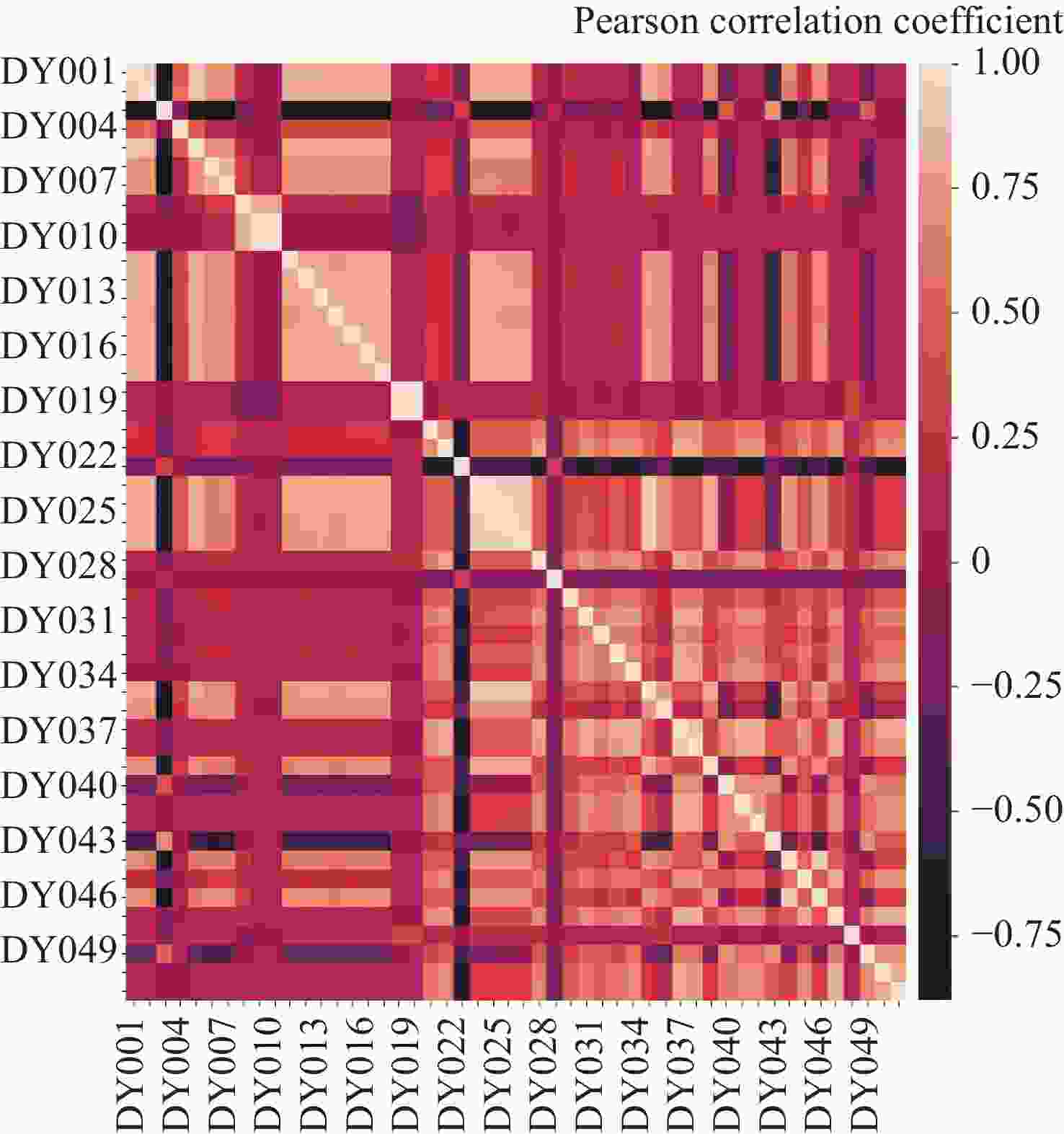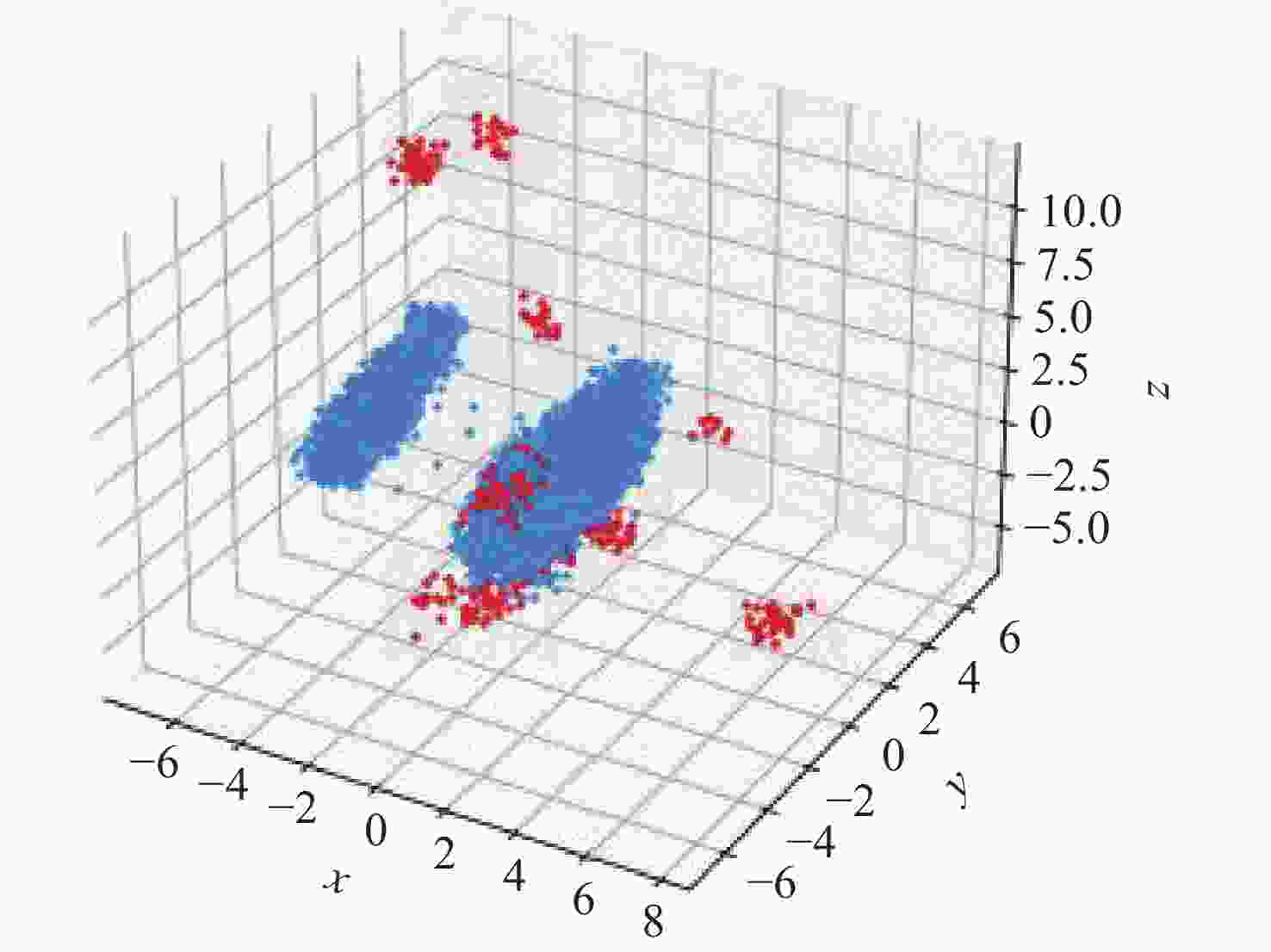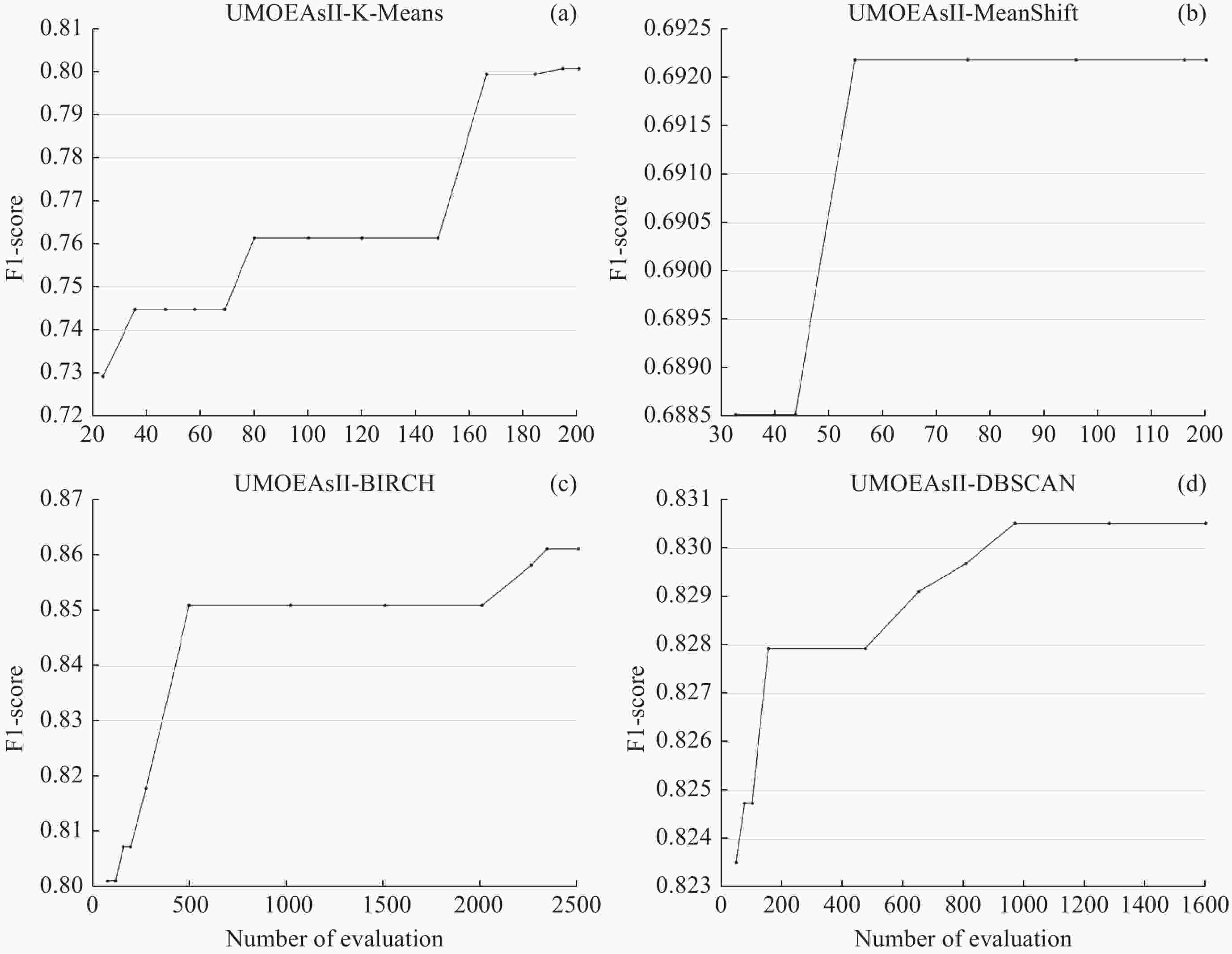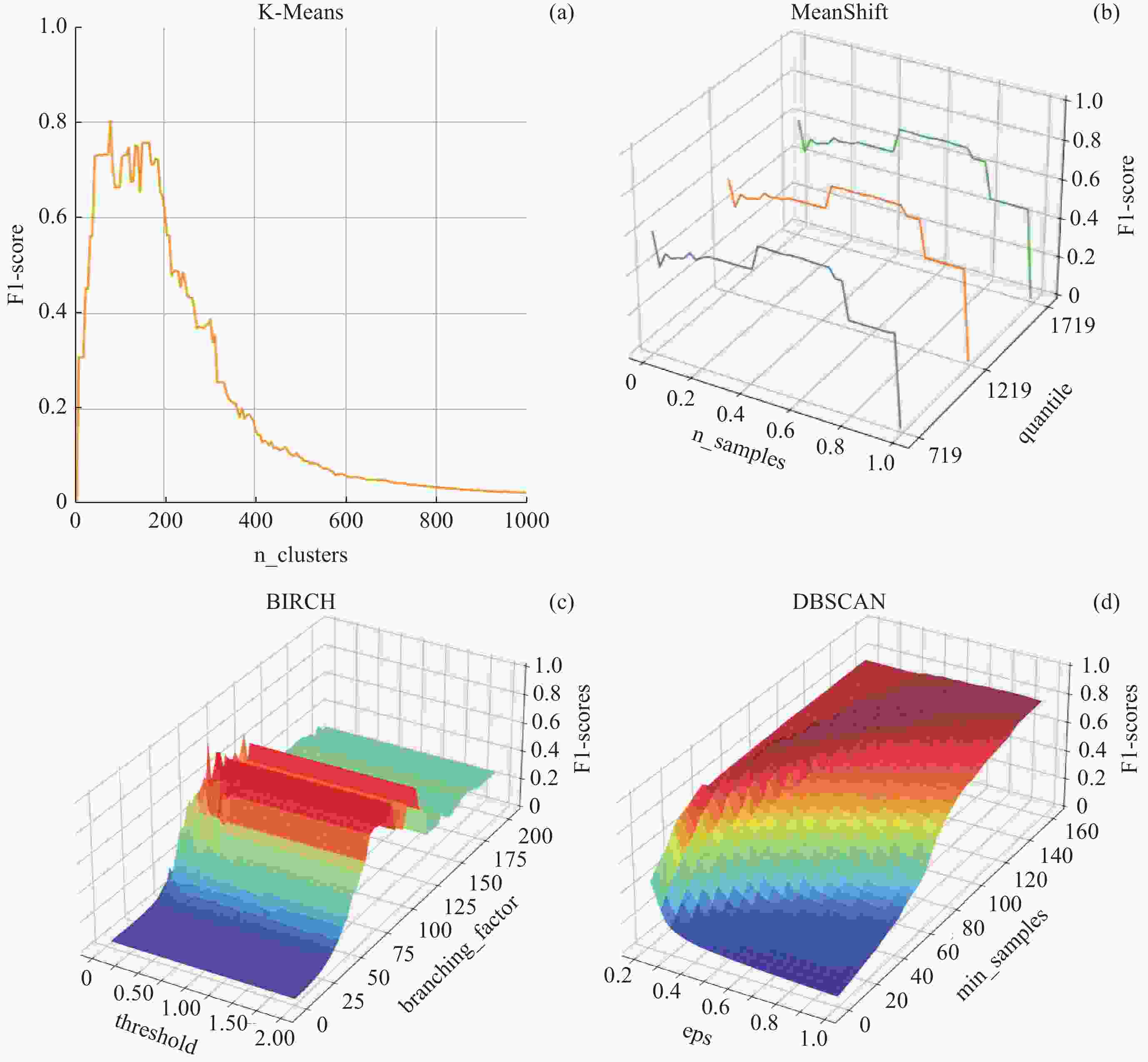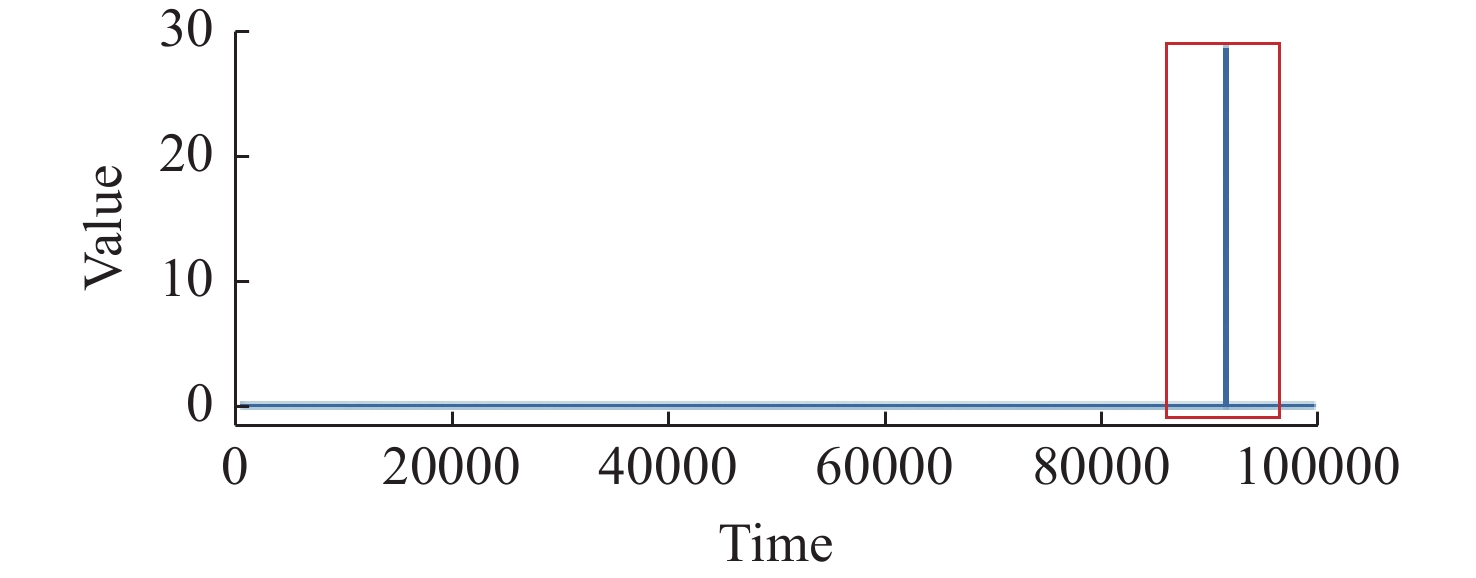基于参数自适应优化聚类的卫星状态异常检测方法
doi: 10.11728/cjss2023.05.2022-0054 cstr: 32142.14.cjss2023.05.2022-0054
Satellite Anomaly Detection Method Based on Parameter Adaptive Optimization Clustering
-
摘要: 对卫星在轨状态进行实时监测和异常检测,有利于保障卫星安全稳定运行。为解决在利用聚类分析检测卫星异常过程中,通过网格搜索选择最佳聚类超参数时精细度差、效率低的问题,本文将聚类超参数选择转化为单目标优化问题,并基于智能优化算法的启发式搜索能力,提出了超参数自适应优化的聚类算法UMOEAsII_BIRCH。为验证自适应搜索的有效性,在卫星遥测数据集和公开数据集上进行了测试。以网格搜索为基准,分别选取基于划分、基于密度和基于层次的聚类算法,对比自适应搜索和网格搜索两种方式下,异常检测的F1-score和算法执行时间。实验结果表明,自适应搜索克服了网格搜索中精细度与效率的矛盾,不受网格点的限制,异常检测效果优于基准方法,且在算法执行效率上具有显著优势。Abstract: Real-time monitoring and anomaly detection of satellites in orbit are conducive to ensuring the safe and stable operation of satellites. In order to solve the problems of poor fineness, low efficiency and limited grid points when selecting the optimal clustering hyper-parameters through grid search in the process of detecting satellite anomalies using cluster analysis, the selection of clustering hyper-parameters is transformed into a single-objective optimization problem. And based on the heuristic search ability of intelligent optimization algorithm, a hyper-parameter adaptive optimization clustering algorithm UMOEAsII_BIRCH is proposed. To verify the effectiveness of adaptive search, tests are conducted on a satellite telemetry data set and a public data set. Using grid search as the benchmark, the clustering algorithms based on partition, density and hierarchy are selected respectively to compare the F1-score of anomaly detection and the algorithm execution time in adaptive search and grid search. The experimental results show that the proposed adaptive search overcomes the contradiction between fineness and efficiency in grid search, and is not limited by grid points. Besides, adaptive search outperforms grid search in the F1-score of anomaly detection, and has a significant advantage in execution efficiency.
-
表 1 混淆矩阵
Table 1. Confusion matrix
预测类别 正例 负例 真实类别 正例 TP FN 负例 FP TN 表 2 UMOEAs-II算法参数设置
Table 2. Parameter settings of UMOEAs-II
最大评估次数 种群大小 问题维度 超参数名称 超参数取值范围 UMOEAsII_MeanShift 120 5 2 quantile [0.01, 1.0] n_samples [500, 2000] UMOEAsII_K-Means 200 8 1 n_clusters [2, 1000] UMOEAsII_DBSCAN 1600 22 2 eps [0.2, 1.0] min_samples [2, 160] UMOEAsII_BIRCH 2500 36 2 threshold [0.001, 2.0] branching_factor [2, 200] 注 问题维度,代表聚类算法要寻优的超参数个数。 表 3 网格搜索测试参数组合
Table 3. Parameter combinations of grid search
算法名称 超参数名称 超参数取值范围 搜索步长 网格点数 MeanShift quantile (0.001, 1.0) 0.025 120 n_samples (500, 2000) 500 K-Means n_clusters (2, 1000) 5 200 DBSCAN eps (0.2, 1.0) 0.02 1600 min_samples (2, 160) 4 BIRCH threshold (0.001, 2.0) 0.04 2500 branching_factor (2, 200) 4 表 4 算法测试结果对比
Table 4. Comparison of algorithm test results
F1-score
最优值F1-score
最差值F1-score
均值F1-score
方差算法执行时间/s MeanShift 0.6922 0.6922 0.6922 0.00000 4780 UMOEAsII_MeanShift 0.6922 0.6922 0.6922 0.00000 4087 K-Means 0.8006 0.7545 0.7871 0.01994 156639 UMOEAsII_K-Means 0.8006 0.7650 0.7969 0.01066 104939 DBSCAN 0.8297 0.8277 0.8286 0.00066 502272 UMOEAsII_DBSCAN 0.8305 0.8294 0.8298 0.00039 394553 BIRCH 0.8519 0.7734 0.8191 0.02580 172106 UMOEAsII_BIRCH 0.8610 0.8542 0.8568 0.00205 86930 注 加粗数据表示最优结果。 表 5 UMOEAs-II算法参数设置
Table 5. Parameter settings of UMOEAs-II
最大评估次数 种群大小 问题维度 超参数名称 超参数取值范围 UMOEAsII_K-Means 200 8 1 n_clusters [2, 1000] UMOEAsII_DBSCAN 1200 22 2 eps [0.1, 1.0] min_samples [2, 160] UMOEAsII_BIRCH 1600 24 2 threshold [0.001, 2.0] branching_factor [2, 200] 表 6 网格搜索测试参数组合
Table 6. Parameter combinations of grid search
算法名称 超参数名称 超参数取值范围 搜索步长 网格点数 K-Means n_clusters (2, 1000) 5 200 DBSCAN eps (0.1, 1.0) 0.03 1200 min_samples (2, 160) 4 BIRCH threshold (0.001, 2.0) 0.05 1600 branching_factor (2, 200) 5 表 7 算法测试结果
Table 7. Algorithm test results
F1-score
最优值F1-score
最差值F1-score
均值F1-score
方差算法执行时间/s K-Means 0.5965 0.5348 0.5674 2.6505×10–2 1091.75 UMOEAsII_K-Means 0.5965 0.5965 0.5965 2.3406×10–16 681.86 DBSCAN 0.4639 0.4470 0.4571 4.7600×10–3 1443.58 UMOEAsII_DBSCAN 0.4671 0.4671 0.4671 4.6800×10–16 1299.00 BIRCH 0.6139 0.4865 0.5379 3.8275×10–2 2944.44 UMOEAsII_BIRCH 0.6415 0.6415 0.6415 0.0000 1351.90 注 加粗数据表示最优结果。 -
[1] PAN D W, LIU D T, ZHOU J, et al. Anomaly detection for satellite power subsystem with associated rules based on Kernel Principal Component Analysis[J]. Microelectronics Reliability, 2015, 55(9/10): 2082-2086 [2] ZHENG L, GUANG J, TANG S H. Fluctuation feature extraction of satellite telemetry data and on-orbit anomaly detection[C]//2016 Prognostics and System Health Management Conference. Chengdu: IEEE, 2017: 1-5 [3] 赵佳, 吕弘, 刘宝, 等. 基于模糊Petri网的卫星导航接收系统故障诊断[J]. 测试技术学报, 2017, 31(5): 438-442ZHAO Jia, LV Hong, LIU Bao, et al. Fault diagnosis for GNSS receiver based on fuzzy Petri Net[J]. Journal of Test and Measurement Technology, 2017, 31(5): 438-442 [4] 张怀峰, 江婧, 张香燕, 等. 面向卫星电源系统的一种新颖异常检测方法[J]. 宇航学报, 2019, 40(12): 1468-1477 doi: 10.3873/j.issn.1000-1328.2019.12.011ZHANG Huaifeng, JIANG Jing, ZHANG Xiangyan, et al. Novel anomaly detection method for satellite power system[J]. Journal of Astronautics, 2019, 40(12): 1468-1477 doi: 10.3873/j.issn.1000-1328.2019.12.011 [5] 李钰骙, 李虎, 胡钛. 基于LightGBM的HXMT在轨运行模式监测算法[J]. 空间科学学报, 2020, 40(1): 109-116 doi: 10.11728/cjss2020.01.109LI Yukui, LI Hu, HU Tai. In-orbit operational pattern monitoring algorithms based on LightGBM for Hard X-ray Modulation Telescope Satellite[J]. Chinese Journal of Space Science, 2020, 40(1): 109-116 doi: 10.11728/cjss2020.01.109 [6] 李虎, 郭国航, 胡钛, 等. 遥测参数数据载荷状态判别集成学习方法[J]. 国防科技大学学报, 2021, 43(6): 33-40LI Hu, GUO Guohang, HU Tai, et al. Ensemble learning for state recognition of payload from telemetry data[J]. Journal of National University of Defense Technology, 2021, 43(6): 33-40 [7] CASAS P, MAZEL J, OWEZARSKI P. UNADA: unsupervised network anomaly detection using sub-space outliers ranking[C]//Proceedings of the 10 th International Conference on Research in Networking. Valencia: Springer, 2011: 40-51 [8] 陆春光, 叶方彬, 赵羚, 等. 基于密度峰值聚类的电力大数据异常值检测算法[J]. 科学技术与工程, 2020, 20(2): 654-658LU Chunguang, YE Fangbin, ZHAO Ling, et al. Abnormal value detection of large power data based on density peak clustering[J]. Science Technology and Engineering, 2020, 20(2): 654-658 [9] WANG H, PENG M J, YU Y, et al. Fault identification and diagnosis based on KPCA and similarity clustering for nuclear power plants[J]. Annals of Nuclear Energy, 2021, 150: 107786 doi: 10.1016/j.anucene.2020.107786 [10] 李楠, 强懿耕, 樊瑞, 等. 基于异常因子的航空器飞行轨迹异常检测研究[J]. 安全与环境学报, 2021, 21(2): 643-648LI Nan, QIANG Yigeng, FAN Rui, et al. On the abnormal detection of the aircraft flight trajectory based on the abnormal factor statistics[J]. Journal of Safety and Environment, 2021, 21(2): 643-648 [11] 彭喜元, 庞景月, 彭宇, 等. 航天器遥测数据异常检测综述[J]. 仪器仪表学报, 2016, 37(9): 1929-1945PENG Xiyuan, PANG Jingyue, PENG Yu, et al. Review on anomaly detection of spacecraft telemetry data[J]. Chinese Journal of Scientific Instrument, 2016, 37(9): 1929-1945 [12] 康旭. 时序遥测数据异常检测方法研究[D]. 南京: 南京航空航天大学, 2018KANG Xu. Anomaly Detection Method for Sequential Telemetry Data[D]. Nanjing: Nanjing University of Aeronautics and Astronautics, 2018 [13] ZHANG T, RAMAKRISHNAN R, LIVNY M. BIRCH: An efficient data clustering method for very large databases[J]. ACM SIGMOD Record, 1999, 25(2): 103-114 [14] 陈婧文. 基于链接改进的BIRCH算法的研究与应用[D]. 长春: 吉林大学, 2019CHEN Jingwen. Research and Application of an Improved BIRCH Algorithm Based on Link[D]. Changchun: Jilin University, 2019 [15] ELSAYED S, HAMZA N, SARKER R. Testing united multi-operator evolutionary algorithms-II on single objective optimization problems[C]//2016 IEEE Congress on Evolutionary Computation (CEC). Vancouver: IEEE, 2016: 2966-2973 [16] ELSAYED S M, SARKER R A, ESSAM D L, et al. Testing united multi-operator evolutionary algorithms on the CEC2014 real-parameter numerical optimization[C]//2014 IEEE Congress on Evolutionary Computation (CEC). Beijing: IEEE, 2014: 1650-1657 [17] HRUSCHKA E R, CAMPELLO R J G B, FREITAS A A, et al. A survey of evolutionary algorithms for clustering[J]. IEEE Transactions on Systems, Man, and Cybernetics, Part C (Applications and Reviews), 2009, 39(2): 133-155 doi: 10.1109/TSMCC.2008.2007252 -
-





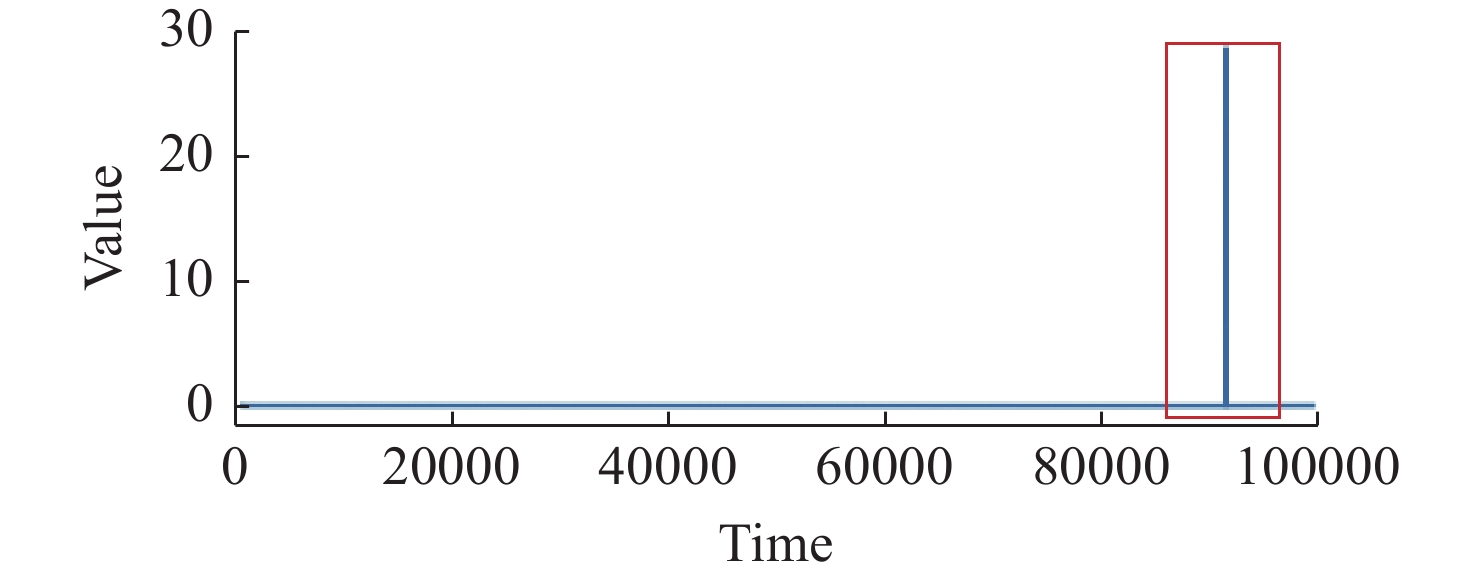
 下载:
下载:


